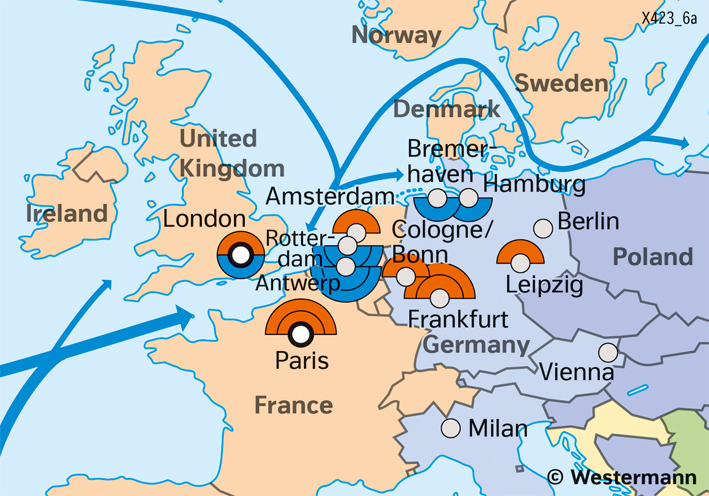The World - Globalised economy and global transport
Economy
978-3-14-100890-6 | Page 46 | Ill. 1

Overview
Over the past four decades, the global economy has experienced a strong growth in international interdependencies. This process is a fundamental aspect of globalisation.
Development of world exports and world economic output
Decisive preconditions for increased international relations were, on the one hand, political decisions to reduce the barriers to economic relations between countries and, on the other hand, the expansion of the material infrastructure. The political measures were supported by the idea that international exchange allows for an optimal use of production factors and resources, saves costs and contributes to the economic development of all participating nations. The General Agreement on Tariffs and Trade (GATT), which led to the founding of the WTO (World Trade Organisation), set the political course. This world trade order liberalised many markets, for example by reducing tariffs and banning non-tariff barriers to trade, and thus significantly facilitated the international exchange of goods.
Moreover, the new order created, at least formally, a similar level for all participants. The agreements of the International Monetary Fund (IMF) led to the emergence of a world monetary order with the abandonment of foreign exchange restrictions and the allowance of free convertibility of currencies. This greatly facilitated global financial transactions for trade in goods and direct investment. The measures of the World Bank favoured the levelling of the economic policy framework conditions in the countries of the world, above all through the expansion of neoliberal orders, which, however, repeatedly gave rise to criticism.
In addition to the political preconditions, technical developments in the transport and communication system led to significant reductions in transport and transaction costs, for example for expenses in the transport of goods and people. Container transport enables closed transport chains for general cargo without costly repackaging, large ship sizes reduce unit costs, and air connections allow the rapid transport of perishable goods such as food and flowers and of time-sensitive goods such as computers. Connections by telephone, fax and e-mail allow constant worldwide contact between business partners. The map shows important elements of international interdependencies and the changes in the importance of spatial units and their international integration that are emerging in the phase of globalisation.
An important feature of globalisation is the international flow of goods. Airports are particularly important for the transport of high-value goods such as microchips and perishable products such as flowers and strawberries. The transport of bulk goods such as ores, grain and oil (see diagram "Development of global maritime trade") is predominantly handled by ocean-going vessels. The handling volume of airports and seaports clearly shows the uneven spatial distribution of global trade. Intensive exchange relations exist between the highly developed countries of North America, Europe and East Asia; more than two-thirds of world trade is accounted for by this so-called triad. Trade between these regions is mainly in high-value industrial goods.
EU economic area
In the EU economic area, economic relations are facilitated even more than is usual and possible on a global scale. Initially, the exchange of goods was made possible without customs barriers; as cooperation progressed, the provision of services and the transfer of production factors became possible in all sub-regions. The free movement of capital facilitates investment, and, thanks to the free movement of labour, it is also possible to work in other countries.
Integration of developing countries
The integration of so-called emerging countries, which are undergoing a rapid development process and in which industry and services are therefore expanding strongly, is relatively new. This group primarily includes some countries in Southeast Asia such as Thailand, Malaysia and Singapore, as well as China, individual countries in Latin America such as Brazil, Argentina and Mexico, and South Africa. All of these countries have advantages in the production of labour-intensive industrial goods such as clothing, electrical appliances and toys due to their low wage costs (see chart "Nominal wages for selected countries") and export these worldwide but are also increasingly gaining importance as locations for corporate headquarters and high-level economic functions.
The degree of integration of countries with a low level of development, which can be recognised in the map by the high proportion of people employed in agriculture, is generally very low. They mainly export primary goods, i.e. agricultural products and raw materials, to the highly developed countries and purchase industrial goods from them. Price fluctuations of their goods on the world market often make their export earnings difficult to calculate. In the case of agricultural products, they are also exposed to strong competition from the highly subsidised agriculture of the USA and Europe.




